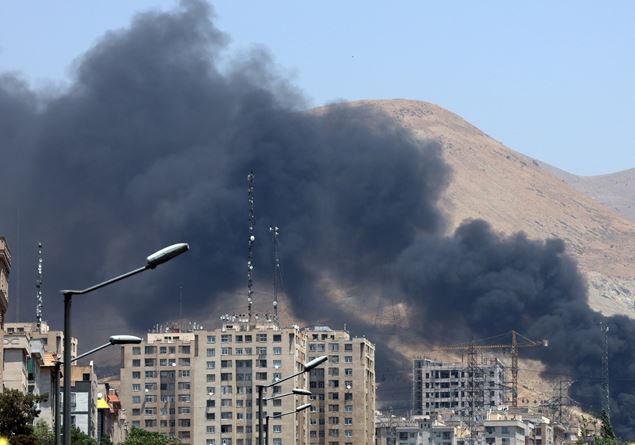Israel hit the heart of the Quds force, the Elite Unit of the Iranian Pasadran, in the midst of the most ferocious military escalation of the history of the relations between Tel Aviv and Tehran. The spokesperson for the Israeli defense forces announced it on Monday. If confirmed, the Raid would represent the hardest blow ever inflicted on the most secret and strategic structure of the Islamic Republic, the long manus of the Khomeinist revolution throughout the Middle East.
From Friday, the day of the start of the Israeli offensive, the skies of the Middle East have no longer known respite. Missiles, drones, surgical bombings and reprisals follow one another relentlessly. According to the Iranian Ministry of Health, the Israeli raids caused at least 224 deaths and over 1,400 injured. In Israel, the ballistic rockets launched by Iran killed 24 civilians and have injured about 600. The objectives affected by Israel exceed the hundred, including missile stations, military bases and strategic installations.
An unprecedented conflict
We are in front of a conflict that could last weeks, not days. Never, not even in the hottest phases of the indirect confrontation between the two countries, had been so far. It is not a limited operation. It is a war. And like all modern wars, he mainly affects civilians. On Monday morning, five people died in Petah Tikva, in the center of Israel, and three others in the north of the country. Tehran, for his part, cries the victims and witnesses an exodus from the capital. Long cars columns have taken the highway to the eastern Azerbaijan, even in the middle of the night.
Israel, for his part, seems intent not to stop until Iran renounces the e -revocation of the uranium, a condition indispensable for the development of a nuclear weapon. But signs do not arrive from Tehran in this regard. “No white flag,” says Sanam Vakil, Chatham House analyst. “Iran’s goal is to survive and demonstrate resilience”.
The attack on the strategic nerve
In addition to military and nuclear sites, there is now the Iranian economic system: energy plants, refineries, vital infrastructures. It is a strategy that aims to weaken Iran cumming about it. The spokesman for the Israeli army spoke of “freedom of action” in the skies above Tehran, a sign that the Iranian aerial defenses would have been compromised. But confidential sources admit that some missile systems are still operational.
However, the most symbolic target remains the quds force. This is the unit that for over twenty years, under the guidance of General Qassem Soleimani, has armed Hezbollah in Lebanon, supported Hamas in Gaza, trained Shiite militias in Iraq and sent weapons to the Houthi in Yemen. After the killing of Soleimani by the United States in 2020, the command passed to Esmail Ghaani. But the charisma and personal networks of the predecessor are difficult to replace.
The risk of enlargement
Then there is the international variable. The United States, although not directly involved, follow the crisis closely. Donald Trump, again in the White House, has not hidden the intention of using Israel’s military successes as a negotiating lever. But if Iran were to accelerate the nuclear program, a US intervention would not be excluded. “Israel will go on until Iran renounce its nuclear program,” warns Daniel Shapiro, former Pentagon councilor. “But without the bombs bunker Buster American, he will not be able to hit underground sites like Fordo.”
The breaking point could arrive right there. Because the enrichment of uranium is the red line. And diplomacy is in stand-by. The talks between Washington and Tehran expected in Oman have been deleted. Iranian Minister Abbas Araghchi reiterated the willingness to guarantee civil use of nuclear power, but without giving up the enrichment. A wall against wall.
A country under siege
In the meantime, Israel faces another emergency: 150,000 citizens blocked abroad due to the closure of the airspace. The Ministry of Defense announced the first aerial bridges, but it will take days before the operations can start. A crisis in the crisis.
Finally, the Hezbollah node remains. The military “beheading” strategy given last autumn in Lebanon seems to repeat itself with Iran. The elimination of high officers serves to destabilize the control chain and to weaken the response capacity. But nobody, not even among Israeli strategists, can predict where all this will bring us.
For now, the only certainty is that the war between Israel and Iran is no longer a war by prosecutor. It is direct, asymmetrical, high intensity. And it could change the balance of the Middle East forever.
The role of the USA and Trump:
It all depends on how the former president Trump will react, who has so far preferred to use Israeli military successes as a leverage to reopen negotiations. But if Iran were to accelerate the atomic program, a direct American intervention would not be excluded.
“This war will end when Trump will decide that he can end,” concludes Yoel Guzensky, an expert in Tel Aviv’s Ass.
(Red.FC.Online)


